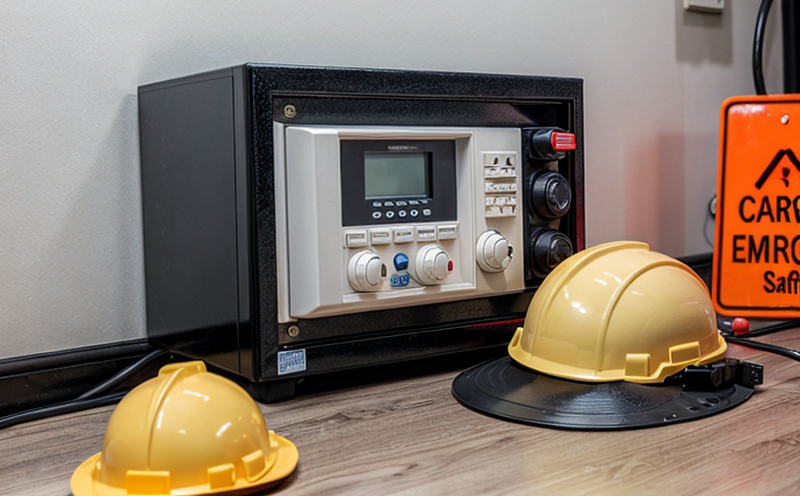ASTM F1475 Fire Extinguisher Discharge Testing
The ASTM F1475 standard test method is a crucial process in the aerospace and aviation industries, ensuring that fire extinguishers meet stringent safety requirements. This test evaluates whether portable fire extinguishers can effectively discharge their contents under simulated real-world conditions. Compliance with ASTM F1475 is essential for manufacturers and suppliers of fire protection equipment within the aerospace sector to ensure that fire suppression systems are reliable and effective.
The purpose of this service is to provide comprehensive testing and certification for fire extinguishers used in aircraft, helicopters, and other aviation-related equipment. The test aims to validate that a fire extinguisher can effectively discharge its contents at specified distances from the ignition source, ensuring it meets the necessary performance criteria defined by ASTM F1475.
ASTM F1475 testing is critical for quality managers and compliance officers responsible for maintaining safety standards in aerospace and aviation environments. This service not only ensures that fire extinguishers are functioning correctly but also helps in identifying potential design flaws or manufacturing defects before they can cause significant issues.
The test procedure involves several steps, including specimen preparation, calibration of the equipment used during discharge, and recording the results based on predefined criteria. The testing process is designed to simulate actual usage conditions as closely as possible, ensuring that the fire extinguisher performs reliably when needed.
Compliance with ASTM F1475 standards is mandatory for all manufacturers supplying fire protection systems in the aerospace industry. This service supports R&D engineers and procurement teams by providing reliable data on the performance of new or modified fire extinguishers. By adhering to these stringent testing protocols, we ensure that only high-quality products are approved for use in aviation applications.
The importance of this test cannot be overstated, as it directly impacts passenger safety during emergencies aboard aircraft and other aerospace vehicles. Ensuring compliance with ASTM F1475 helps maintain the highest level of safety standards, which is paramount given the critical nature of these environments.
Scope and Methodology
| Test Criteria | Description |
|---|---|
| Discharge Pattern | The discharge pattern is evaluated to ensure that the fire extinguisher delivers its contents in a manner consistent with effective suppression of flames. |
| Distance from Ignition Source | The test assesses how far away from an ignition source the fire extinguisher can still effectively discharge and suppress flames. |
| Duration of Discharge | The duration over which the fire extinguisher maintains its effectiveness in suppressing a flame is measured to ensure it meets minimum requirements. |
| Flame Suppression Efficiency | This measures how well the fire extinguisher reduces or eliminates flames during discharge, ensuring effective firefighting capabilities. |
The ASTM F1475 test method includes detailed guidelines for specimen preparation and equipment calibration. Specimens are prepared according to specific dimensions and weights provided in the standard. Calibration ensures that all measuring devices used during testing are accurate and consistent, providing reliable data throughout the process.
The methodology involves simulating real-world conditions as closely as possible by using controlled environments where ignition sources are strategically placed at set distances from the fire extinguisher under test. This allows for precise measurement of discharge performance parameters such as distance, duration, and flame suppression efficiency.
Benefits
The benefits of ASTM F1475 fire extinguisher discharge testing extend beyond mere compliance with regulatory requirements; they contribute significantly to enhancing overall aviation safety. By ensuring that fire extinguishers meet the strictest performance criteria, this service supports critical operational functions within aircraft and other aerospace vehicles.
- Enhanced Safety: Ensures that fire suppression systems are reliable under simulated real-world conditions, thereby protecting passengers and crew in case of emergencies.
- Regulatory Compliance: Helps manufacturers and suppliers meet mandatory standards set by regulatory bodies like ASTM, ensuring legal compliance and avoiding potential penalties.
- R&D Support: Provides valuable data for R&D teams to refine designs based on empirical evidence from actual testing scenarios.
- Purchasing Confidence: Offers a high level of assurance that the fire extinguishers purchased are reliable and effective, enhancing trust between suppliers and end-users.
The results of ASTM F1475 testing serve as a benchmark for evaluating the effectiveness of different models of fire extinguishers. This information is invaluable for both procurement teams and R&D engineers who rely on accurate performance data to make informed decisions about equipment selection and improvement.
Moreover, by consistently meeting these stringent standards, aerospace companies can build a reputation for excellence in safety practices, which is crucial given the high stakes involved in aviation operations. This service plays a pivotal role in maintaining public trust and ensuring that essential safety measures are never compromised.
Quality and Reliability Assurance
- Calibration of Equipment: All instruments used during testing must be regularly calibrated to ensure accurate measurements. This includes thermometers, pressure gauges, and other devices that measure key parameters like temperature change and flame intensity.
- Standard Operating Procedures (SOPs): Our laboratory adheres strictly to established SOPs which outline the exact procedures for conducting ASTM F1475 tests. These SOPs cover everything from specimen preparation to data analysis, ensuring consistency across all tests performed.
- Data Validation: Each test result undergoes rigorous validation checks before being finalized. This includes cross-referencing results with previous tests on the same model or similar models to ensure accuracy and reliability.
- Training of Personnel: Our staff receives comprehensive training in ASTM F1475 methods, including hands-on practice sessions led by experienced professionals. Regular refresher courses are also provided to keep our team up-to-date with any changes or updates to the standard.
Quality and reliability are paramount when it comes to fire extinguisher performance testing. By implementing these robust quality assurance measures, we ensure that every test conducted meets the highest standards of accuracy and precision. This commitment to excellence ensures that our clients receive reliable information they can trust for making critical decisions about their equipment.





